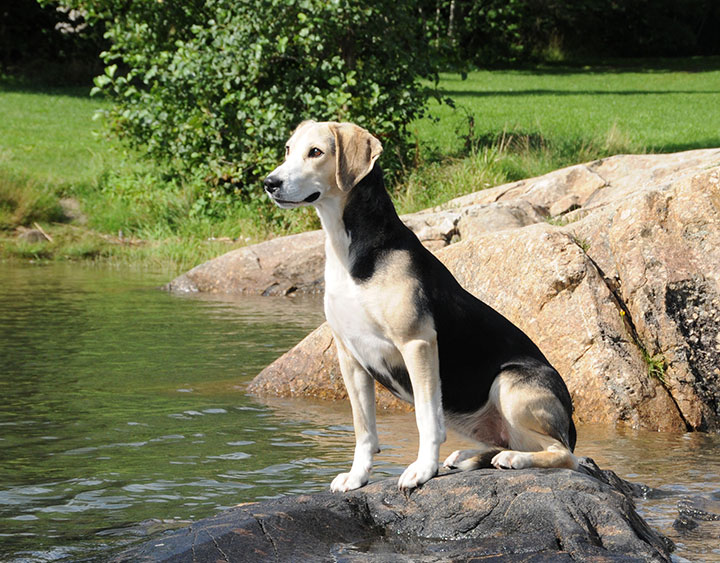The Norwegian Hound (Dunker in Norwegian) is named after the Norwegian captain Wilhelm Conrad Dunker, who created the breed by crossing several scent hound breeds in the first half of the 19th century.

Photographer: Vibeke Brath
The Norwegian Hound (Dunker in Norwegian) is named after the Norwegian captain Wilhelm Conrad Dunker, who created the breed by crossing several scent hound breeds in the first half of the 19th century. The ”Special Club for Norwegian Hare Hounds” was founded in 1902. In the same year, the hare hounds were split into two main groups, which are known today as the Norwegian Hound and the Hygen Hound.
The Norwegian Hound group was large and included local hare hound populations from all over the country. The breeding base was thus broad and heterogeneous. One characteristic trait of the Norwegian Hound has always been the blue-marbled (dappled) coat colour and walleyes, although the breed standard also allows other colours. During the Second World War there was little demand for Norwegian Hound puppies, making it difficult to maintain systematic breeding of high quality.
After the war, interest in the breed increased significantly until the 1970s, after which the breed’s popularity again dwindled – presumably due to competition from foreign breeds. In the 1980s, the Norwegian Hound was a very homogenous breed with excellent hunting abilities. However, due to inbree¬ding, most dogs were too closely related. In 1987, the breeding committee for the Norwegian Hound therefore applied for permission to crossbreed with other breeds, but the application was denied by the Norwegian Kennel Club. Two years later, though, permission for some crossbreeding was granted. This has given the breed much better genetic variation and health, but maintained its typical and positive characteristics.
In recent years, the number of Norwegian Hound puppies registered by the Norwegian Kennel Club varied between 131 and 180 per year. This figure is so low that it is necessary to increase the breed’s numbers in order to enable efficient and healthy breeding in the future.
Appearance and size
The Norwegian Hound is a medium-sized, distinctly rectangular dog, strongly built, but should not appear heavy. The head should have good length, the skull slightly domed with a prominent occiput and a defined, but not too deep or abrupt stop. Its ears are medium high set and hanging. The iris can be of different colours in blue-marbled (dappled) dogs. Medium-long tail should be carried straight or in a slight upward curve. The coat is straight, hard, dense and not too short. Coat colour should be black or blue-marbled (dappled) with pale fawn or white markings. Predominant black or white and too warm brown colours are not desirable. Height at the withers for males is 50-55 cm, for bitches 47-53 cm.
Utilization
The Norwegian Hound is considered to be a good scent hound. It cooperates closely and well with its owner in the woods and bays on the trail. Breeding efforts have always aimed at strengthening the best characteristics of the old Norwegian scent hound, which was a hardy and robust dog with an excellent temperament. Today’s hunters especially call attention to the breed’s strong paws. These tolerate ice and crusty snow much better than the feet of other scent hounds. The Norwegian Hound is characterised by strong nerves and by being especially sociable and trusting. Many Norwegian Hounds have done very well in hunting trials. They can thus be characterised as an excellent combination of a hunting and companion dog. Due to its good temperament and open nature, the breed is also easy to train.
Breed registration statistics
Below you can find the registration statistics for the Norwegian Hound in the Nordic countries from 1990 onwards.
| | Norway | Denmark | Finland | Iceland | Sweden |
|---|
| 2015 |
174 |
0 |
0 |
0 |
2 |
|---|
| 2010 |
124 |
0 |
0 |
0 |
1 |
|---|
| 2005 |
132 |
0 |
0 |
0 |
3 |
|---|
| 2000 |
233 |
0 |
0 |
0 |
3 |
|---|
| 1995 |
249 |
0 |
0 |
0 |
16 |
|---|
| 1990 |
332 |
0 |
0 |
0 |
24 |
|---|